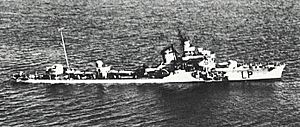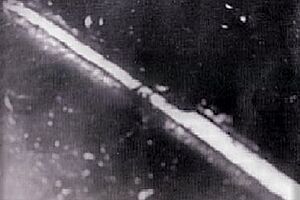Battle of the Tarigo Convoy facts for kids
Quick facts for kids Battle of the Tarigo Convoy |
|||||||
|---|---|---|---|---|---|---|---|
| Part of the Battle of the Mediterranean of World War II | |||||||
 Italian destroyer Lampo; heavily damaged and beached during the battle, the ship was later salvaged by the Italian Navy |
|||||||
|
|||||||
| Belligerents | |||||||
| Commanders and leaders | |||||||
| Strength | |||||||
| 4 destroyers | 3 destroyers | ||||||
| Casualties and losses | |||||||
| 43 killed 1 destroyer sunk |
350-1,800 killed 2 destroyers sunk 1 destroyer beached 4 cargo ships sunk or destroyed |
||||||
The Battle of the Tarigo Convoy was a naval battle during World War II. It happened on April 16, 1941, in the Mediterranean Sea. This battle was part of the larger Battle of the Mediterranean.
It involved four British destroyers and three Italian destroyers. These ships were escorting a group of supply ships. The fight took place near the Kerkennah Islands, off the coast of Tunisia. The battle is named after the Italian lead ship, the destroyer Luca Tarigo.
During World War II, controlling the sea was very important. Both sides wanted to protect their own supply ships. They also wanted to stop enemy convoys. Convoys carrying supplies to North Africa were vital for the German and Italian armies. British attacks often came from Malta, which also needed supplies by sea.
The Battle Begins
In April 1941, a group of five Axis ships left Naples, Italy. They were heading to Tripoli, in North Africa. Four of these ships were German troopships. One was an Italian ship carrying ammunition.
Three Italian destroyers protected this convoy. They were the Luca Tarigo (the lead ship), Baleno, and Lampo. Commander Pietro de Cristofaro led these ships. Bad weather delayed the convoy, but they set sail on the evening of April 13.
The British knew about the convoy thanks to intercepted radio messages. On April 15, a British reconnaissance plane spotted the convoy. It followed the ships from above. Two Italian planes that were supposed to protect the convoy did not arrive. This was also due to the bad weather.
Night Attack
During the night of April 15–16, British ships found the convoy. The British force was the 14th Destroyer Flotilla. It included HMS Jervis, HMS Janus, HMS Nubian, and HMS Mohawk. Captain Philip Mack was in charge. At least three of these British destroyers had radar. Radar helped them see in the dark.
The Italian convoy was moving around shallow waters. These waters were near the Kerkennah Islands. The British used their radar to surprise the Axis convoy. They opened fire from about 2,000 yards away. They then moved in very close, sometimes as near as 50 yards.
Three of the Axis transport ships were sunk. The other two ran aground on a sandbar. They were completely lost. The Italian destroyer Lampo also ran aground. It was later saved and repaired. The Baleno sank in the shallow water.
Commander de Cristofaro, on the Tarigo, was badly wounded. He later died. He received a high Italian military award after his death. Even while sinking, the Tarigo managed to fire two torpedoes. These torpedoes hit HMS Mohawk. The Mohawk was badly damaged and began to sink. The British ship Jervis fired at the Mohawk's bow to make sure it sank completely.
This battle was a big win for the British. It ended the easy supply trips for the Axis to Libya.
Aftermath and Rescue
After the battle, Italian naval forces quickly started a rescue mission. Many ships helped, including destroyers, torpedo boats, and rescue ships. They rescued 1,271 survivors. About 3,000 men had been on board the Axis ships.
Italian forces also found the sunken HMS Mohawk. It was lying on its side in shallow water. Italian divers, pretending to be local fishermen, explored the wreck. They found important documents and other items. Some researchers believe these documents helped with a later Italian attack on Alexandria.
The destroyer Lampo was pulled from the water. It took four months to salvage it. The ship was repaired by May 1942. However, it was sunk again in April 1943. One of the German transport ships, Adana, sank hours after the battle. Another, Arta, was later destroyed by a British submarine.
The number of Axis soldiers and sailors lost varies. Reports say between 350 and 1,800 men were killed. The British lost 43 men, all from the Mohawk.


